
|
|
From the Editor - December 1st , 2017
I'm encouraged to note that reader engagement with this web-site continued to expand during October, the last month for which complete data are available at the time of writing (although November is shaping up well). The number of hits in October established a new high figure of 534,521, finally passing the half-million mark and comprehensively erasing the former record of 497,885 set in March 2017. The visibility of the site is evidently being well sustained. As might be expected, these hits translated into a commensurately increased total of 13,947 actual visits - a significant increase over the September figure, albeit still slightly below the record March total of 14,268. The number of pages accessed also increased to 84,598 for a per-visit average of just over 6 pages - little changed from the September average and certainly indicative of a healthy ongoing level of visitor engagement. Thanks to all of you for being a part of that! Some of you may be wondering why I pay such close attention to the monthly visitation data for this site, to the extent of publishing the information with every Editorial. It's really very simple - these figures allow me to monitor the level of interest in what I'm doing here. They also allow my readers to remain abreast of the general level of ongoing interest in classic and collectible model engines. No sense preaching to a non-existent congregation! In a very real sense, those numbers are my incentive for spending the very considerable time (and money) required to keep this up. If the numbers eventually fall to marginal levels, that'll be the time to stop. Until then - onwards!!
My article this time is devoted to the early attempts to popularize the glow-plug motor in Britain during the late 1940's and early 1950's. As history records, these efforts did not succeed in weaning the average British modeller away from his trusty diesels at that time - although glow-plug engines were certainly used throughout in specific applications, it took the British 1/2A glow-plug "revolution" of 1959-1960 to start the glow-plug motor down the road to widespread long-term acceptance in Britain. However, it's an entertaining story nonetheless. This is only one of a number of interesting articles which appear in this issue, as they do with every issue. If you aren't already a subscriber, you're missing out!! I'm very pleased to be able to report that after taking some time off to deal with family-related issues, Andrew Boddington has resumed his duties as Editor of "Aero Modeller". Sincere thanks are due to Ken Sheppard for filling in so ably during Andrew's absence.
The magazine appears on an irregular basis as and when Ingemar finds the time to produce a new issue, but it is nonetheless well worth a subscription. Contact Ingemar directly to learn about subscribing!
If you aren't already a subscriber, you're missing a lot of really fascinating information! Contact Time Dannels through the ECJ web page to arrange your subscription. This level of ongoing effort richly deserves our support! Despite my repeated admonitions not to do so, people have continued to try to register on this website. As I've already stated repeatedly, this has no effect whatsoever - it's simply an artefact left over from the generic platform's intended use as an on-line sales site. Since this is not a sales site, the registration feature is redundant and I make no use of it whatsoever. Please don't bother - it simply creates unnecessary cyber-clutter! This message will clearly have to become a regular feature of these Editorials........... Over the past month, I've once again had the good fortune to hear from an amazing number of valued contacts from around the world, including Andrew Boddington, Maris Dislers, David Burke, Derek Butler, David Zwolak, Dirk Tollenaar, Paul Rossiter, Peter Hogan, Alan Strutt, Miles Patience, Luis Petersen, Ingemar Larsson, Jens Geschwendtner, Peter Valicek, Mike Conner, Zoe Quilter, Tom Coletta, Gianni Mattea, Johnny Shannon, Luke Roy, Don Sohn, Tim Dannels, Lars Gustafsson, Ken Croft, Sergio Montes, Paul Praus, Grzegorz Zesiek, Peter Rathke, Hans Tegtmeier and Jim Dunkin. Sincere apologies to anyone whom I may have inadvertently missed in the crowd! The story of the 1960 World Control Line Speed Championship which was included in my recent article on the Super Tigre classics just won't lie down! During November I heard from Italian reader Gianni Mattea, who was an eyewitness to the event. At the time, young Gianni was in Budapest on holiday with some friends of his parents. As a keen model enthusiast, he naturally persuaded his hosts to take him to the contest at Buadörs. He was present for the key flights described in my article.
I said "almost all" because there were a few exceptions, namely the American team with their monoline equipment. Gianni recalls that they were alone among the top competitors in not resorting to whipping, which makes Bill Wisniewski's clear-cut win all the more impressive. In Gianni's eyewitness opinion, Bill Wisniewski was undoubtedly the true winner of the contest on the field. Taking the whipping out of it, he considers that a fair result would have been Wisniewski, Nightingale and Rossi in that order, since Rossi had shown in Brussels the previous year that he could reach 225 km/hr without "help" and could amost certainly have done so again in 1960 if he had given it a fair try. Gianni discounts Pech's best speed because it too was apparently produced by strenuous whipping. Gianni also raised the unsubstantiated possibility that the Czech team may have somehow got hold of some tetra-nitromethane themselves for the third round, either from the Americans or from some other source. His basis for raising this possibility (which is all that it is) is the fact that Pech's speed leapt from a second-round 213 km/hr up to 227 km/hr using the same monoline equipment. Moreover, the speeds achieved at this meeting by the top Czechs using the MVVS 2.5R-59 were consistently some 15 km/hr faster than those achieved using the same equipment both before and after the 1960 contest. An interesting speculation, but one which will probably have to remain forever unresolved. Regardless, my very sincere thanks to Gianni for sharing his first-hand recollections with us! I've added a few lines to the original article to reflect this information. With all the attention which my various articles seem to have drawn to the Control Line Speed World Championships of the classic era, it seems highly appropriate to draw interested readers' attention to an excellent website which incorporates a great deal of detailed information on these events. This is the fine F2A Speed site which is based in very large part upon the documentary collection of Pete Soule. My thanks to my good friend Johnny Shannon for drawing my own attention to this fascinating site! Check it out .........
In response, Derek's fellow Aussie Bob Allan posted a couple of photos of one of his engines which appears to be identical apart from lacking any colour anodizing. He stated his firm belief that both his engine and mine are examples of the work of the talented constructor Hans Drenkhahn (1929 - c. 1998) of East Germany (as it was then), creator of the relatively little-known Dremo model engine range. In support of his suggested identification, Bob cited the very unusual head fasteners as a potential clincher, quoting a comment from a German collector which had been posted some time previously regarding a larger "mystery engine". This quote read as follows: "The mystery engine (not my unit, please note!) is a 10 cc Dremo, made by Hans Drenkhahn. The head screws are not original - usually they should be threaded bolts with special slit nuts" It was the latter observation which led Bob to suggest that this is an undocumented 2.5 cc Dremo diesel. Hans Drenkhahn is evidently known for making use of such fasteners - I'm presently unaware of any other commercial model engine manufacturer who did so. Several readers had independently commented earlier that my engine displays several features reminiscent of Drenkhahn's work, most notably the style of the upper crankcase below the exhaiust stack as well as the large-diameter cylindrical main bearing housing. The architectural evidence appeared to be mounting ........
On the basis of Bob's very persuasive comments, I re-directed my focus back to Germany, contacting my valued German colleague Peter Rathke to bring the new information to his attention. It was Peter who finally turned the key that unlocked the truth about this engine by getting in touch with his friend Professor Dr. Hans D. Tegtmeier, who was personally well acquainted with Hans Drenkhahn and is probably as knowledgeable as anyone regarding Drenkhahn's activities. Professor Tegtmeier (who prefers to be known simply as Hans in model engine circles) was able to confirm that this is indeed an example of Hans Drenkhahn's work. It is probably one of his earlier designs under the Dremo label, likely influenced by an examination of the MVVS 25D-1958 from neighbouring Czechoslovakia (as the Czech Republic was then). It probably dates from 1959.
I may have drawn a blank in Poland during my efforts to identify this engine, but I certainly gained a lot of new friends and colleagues there! The amount of information that materialized from the resulting contacts was more than sufficient to allow me to start work on the development of an article about the early post-WW2 history of model engine development and manufacturing in Poland and in particular the work of one of Poland's most prominent model engine designers, Stanislaw Górski (1923-1978). This article will appear in due course on this website - watch for it! The blog site has continued to generate a certain amount of traffic - thanks for that. However, a good deal of the traffic over the past month has been of the highly unwelcome variety - the site became a target for a growing number of computer-driven cyber-spammers. Unfortunately, this commonly happens to blog sites which are insufficiently protected against such unwelcome attention. Naturally I've been trashing them all - none have actually made it onto the site. However, it took time, which I don't have.
The response has been to replace the old question with a new security protocol. When you go to the "Leave a Reply" box, you'll now see a 5-digit number which is represented by a series of black-on-white and white-on-black "dice" as well as regular numbers in both white-on-black and black-on-white formats. You simply have to type the indicated number in the space below. In the illustrated example, the correct number to type would be 37329. This will make it many orders of magnitude harder for the computer-spammers to crack the site. They now have to decode a five-digit number whch is represented in a random mix of four distinct formats. Even more challenging, the code will be different for each attempt to post. This seems to have sorted the problem, at least for now - I've had no spam reach the "pending" folder since this system was initiated. Whew ....what a relief!! But that's by no means all!! A commonly-voiced criticism of my blog site has been the fact that readers couldn't post images there. It was a very valid criticism, since the lack of this facility greatly reduced the site's utility as a discussion forum. My ever-helpful IT mentor Todd Higden of Frontline Multimedia looked for a solution to this issue, and came up in spades! You'll now see an additional prompt allowing you to upload attachments in a variety of formats. I hope that this will significantly enhance the value of the blog site. Please note the maximum document size limit of 32 MB, though. One of my reasons for establishing the blog site was frankly a rather selfish one - I needed some means of soliciting input to articles This month's feature article sees a return to America for an in-depth look at one of the most fascinating and "out of the rut" racing engines of all time - the 1945 Ken 61. While it never set any performance records or achieved any noteworthy competition successes, this unique engine remains one of the most original designs of them all from a purely technical standpoint. It appeared in both diesel and glow-plug versions as well as the "standard" spark ignition format. I think you'll find it as interesting to read as I did when carrying out the research! Definitely "one for the books", as they say .........!!
This month's bonus article represents just such a contribution. My good mate Maris Dislers has very kindly written up the very interesting behind-the-scenes story of the development of the Australian-made Taipan Schnuerle-ported engines which began to appear in late 1972. New model engine designs don't materialize out of nowhere - there's always a period of development and testing behind them. Maris's article vividly portrays the kind of process that any model engine designer has to go through in order to bring an entirely new product to the marketplace. My very sincere thanks go out to Maris for his efforts, which were very generously supported by David Burke of Adelaide Aeromotive Pty. Ltd., the current bearers of the Taipan standard.
David's latest contribution to the preservatioon of the Taipan name has been to arrange for the production of a limited number of tee-shirts bearing the Taipan name and logo. I feel privileged to have received one of these shirts, which I wear with pride! My very sincere thanks to David and to his US colleague Dave Zwolak for making this possible!
By way of a bonus, I also plan to include another installment in my series of tests of classic 2.5 cc racing engines of the 1950's. This time it'll be the turn of the 1957 Vltavan 2.5 from Prague, Czechoslovakia (as the Czech Republic was then). This potent-looking unit was basically a clone of the very successful MVVS I think that's it for now. I'll be back to you with another issue on or about January 1st, 2018. Meanwhile, have a safe and enjoyable festive season, and may the heady aroma of diesel fumes or burning nitro assault your nostrils soon............... ! Cheers, Adrian Duncan Coquitlam, British Columbia, Canada ___________________________________ Note regarding material to be found on this site - unless specifically otherwise noted, all images and text which appear on this site are my own work, and I hereby assert my right to be recognized as the originator of this material. For the record, this material is made freely available to all upon two firm conditions:
Adrian C. Duncan Coquitlam, BC, Canada
|
| |
 Boy, it's hard to believe that we're only a few weeks away from Christmas 2017! It seems like only yesterday that we were recovering from the effects of the 2016 festive season, and now here we go again in 2017! How did we survive the last go-round, and where did the last twelve months go.....?!?
Boy, it's hard to believe that we're only a few weeks away from Christmas 2017! It seems like only yesterday that we were recovering from the effects of the 2016 festive season, and now here we go again in 2017! How did we survive the last go-round, and where did the last twelve months go.....?!?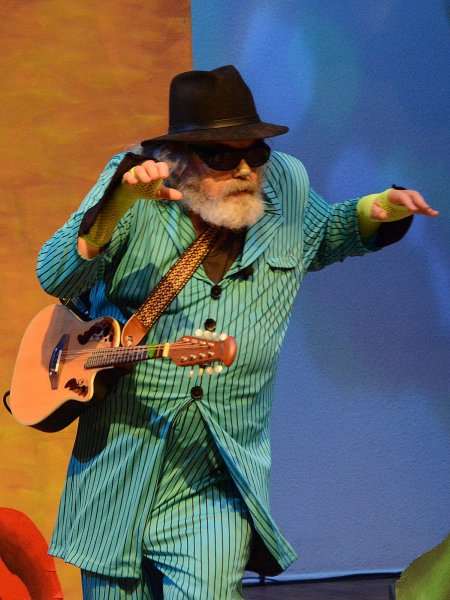
 December 2017 is another double publication month for me, since in addition to this issue of my website I also have an article in the December 2017 issue (no. 967) of "
December 2017 is another double publication month for me, since in addition to this issue of my website I also have an article in the December 2017 issue (no. 967) of "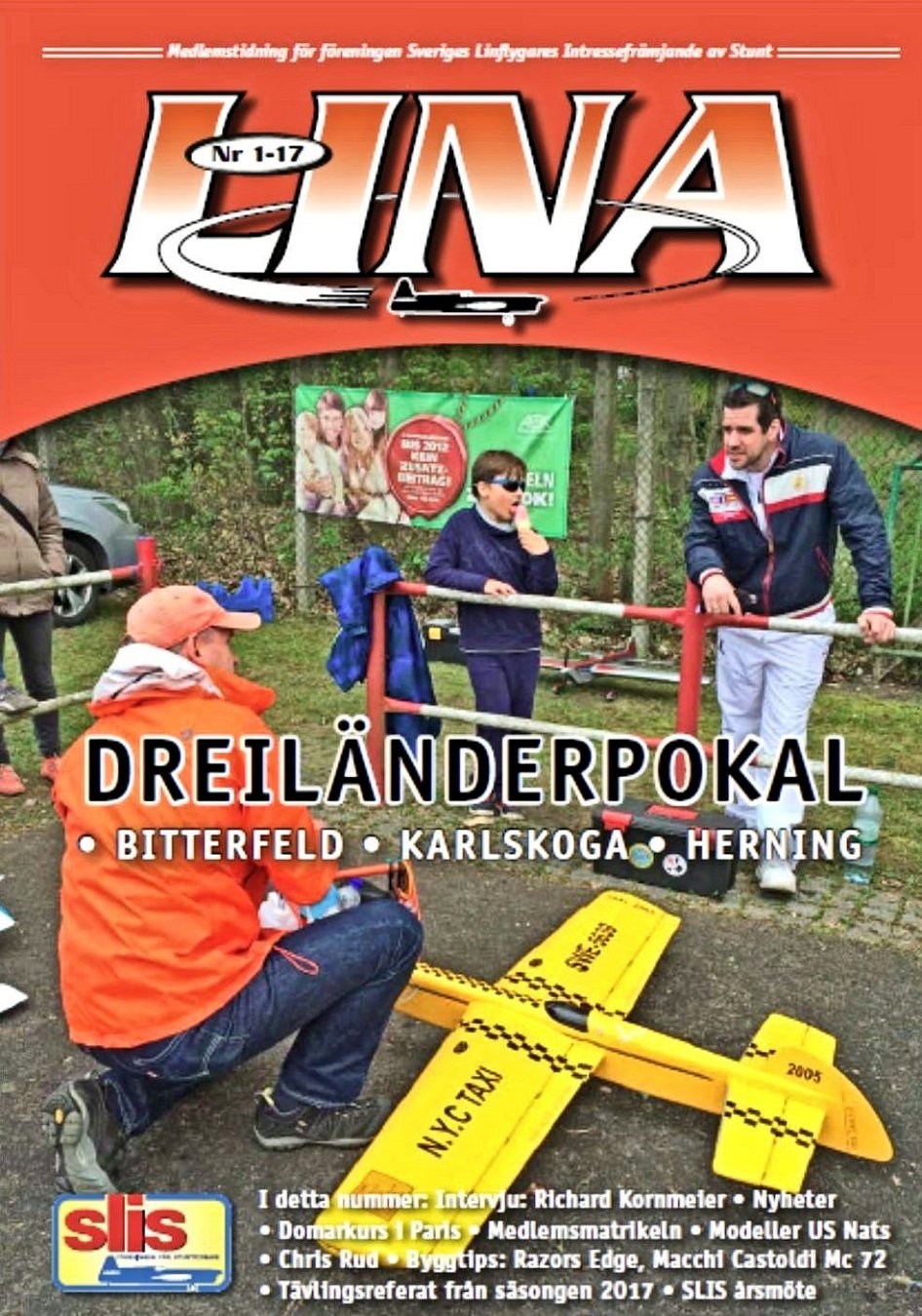 On another publication-related note, I was very pleased to receive my electronic copy of issue no. 1-17 of the outstanding Swedish control-line magazine LINA, which has been mentioned before on this site. Edited by Ingemar Larsson, this finely-produced magazine presents articles on a wide range of topics relating to control line, including contest reports, interviews with notable personalities and (from time to time) model engines. Around one-third of the content is presented in English, while the rest is easily accessible in any language using current OCR and translation technology. The photographs are all in color and are reproduced to a high standard.
On another publication-related note, I was very pleased to receive my electronic copy of issue no. 1-17 of the outstanding Swedish control-line magazine LINA, which has been mentioned before on this site. Edited by Ingemar Larsson, this finely-produced magazine presents articles on a wide range of topics relating to control line, including contest reports, interviews with notable personalities and (from time to time) model engines. Around one-third of the content is presented in English, while the rest is easily accessible in any language using current OCR and translation technology. The photographs are all in color and are reproduced to a high standard. 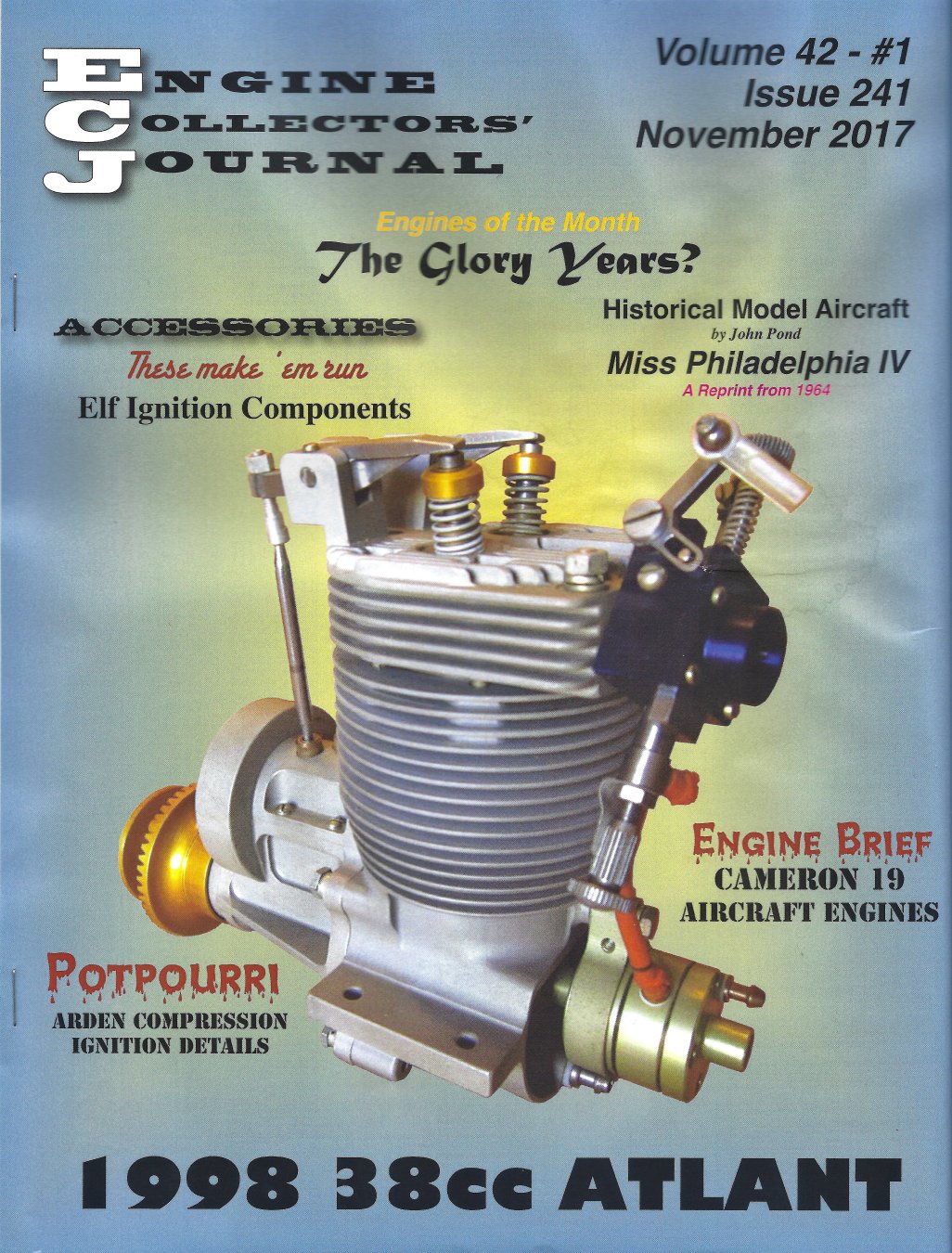 As always, another very welcome arrival in my mail-box was issue no. 241 of the indespensable "
As always, another very welcome arrival in my mail-box was issue no. 241 of the indespensable " Gianni agrees completely with my assessment of Ugo Rossi's clearly-illegal tactics, stating that he was well known in Italy and elsewhere as having "a very strong right arm". However, he also supports my comment that almost all of the speed competitors whipped to varying degrees. In Gianni's recollection, this even extended to the Czech team, Pech in particular achieving both his third round contest speed and his subsequent World Record through the use of significant whipping of his monoline model.
Gianni agrees completely with my assessment of Ugo Rossi's clearly-illegal tactics, stating that he was well known in Italy and elsewhere as having "a very strong right arm". However, he also supports my comment that almost all of the speed competitors whipped to varying degrees. In Gianni's recollection, this even extended to the Czech team, Pech in particular achieving both his third round contest speed and his subsequent World Record through the use of significant whipping of his monoline model.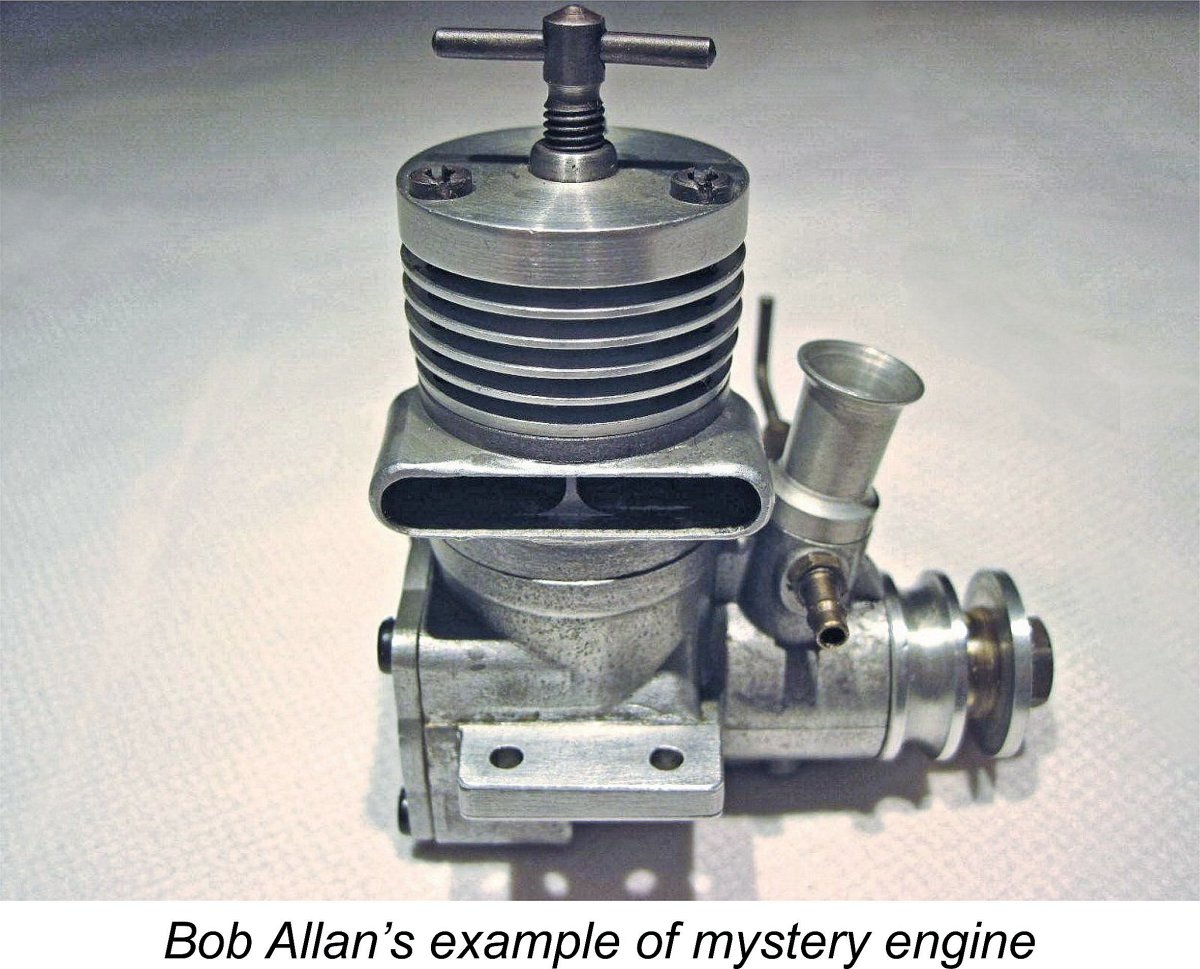
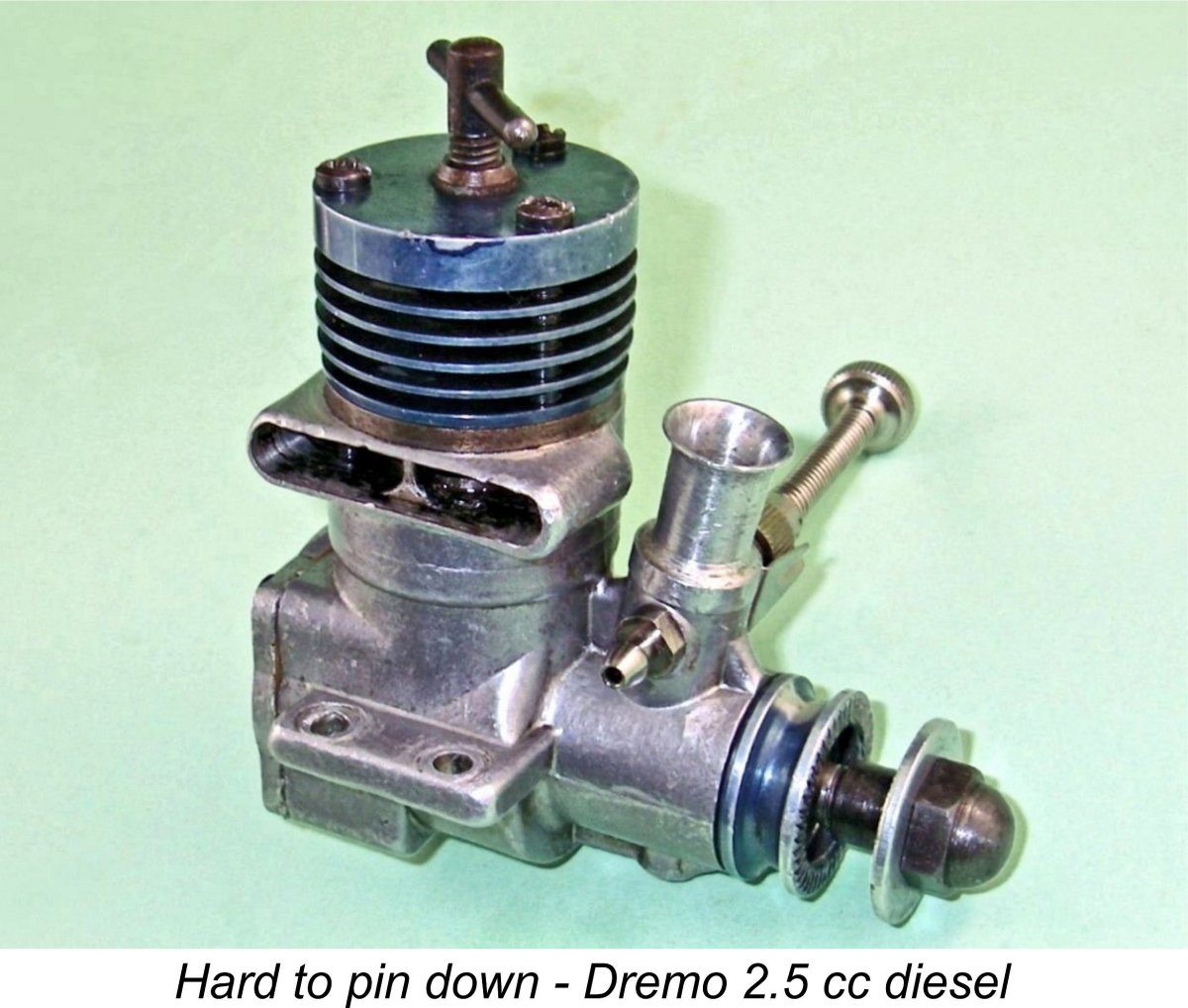 Bob commented that Hans Drenkhahn was given to experimentation, producing a lot of engines with widely varying styles unlike, say, Enya, whose classic products generally reflected a very recognizable basic design standard. However, there are a few distinctive styling clues which identify Drenkhahn's work - those unique head fasteners are apparently one of them. Drenkhahn evidently went so far as to make these fasteners himself, which cert
Bob commented that Hans Drenkhahn was given to experimentation, producing a lot of engines with widely varying styles unlike, say, Enya, whose classic products generally reflected a very recognizable basic design standard. However, there are a few distinctive styling clues which identify Drenkhahn's work - those unique head fasteners are apparently one of them. Drenkhahn evidently went so far as to make these fasteners himself, which cert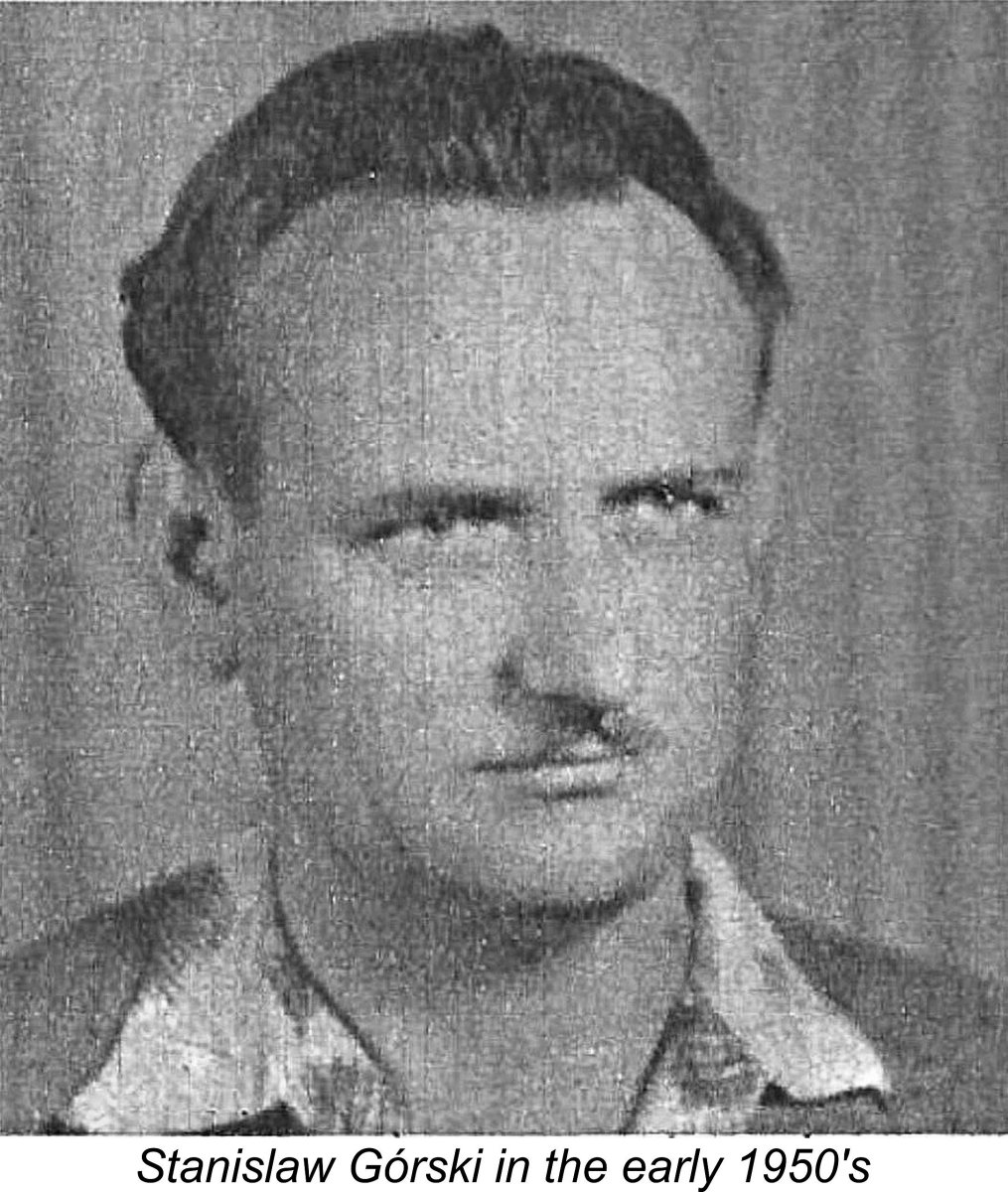
 The problem was down to the fact that my original anti-computer "security" question had only two possible answers - hot or cold. All the spam computers had to do was try both - the one that worked would be recorded, and they were in, at least to the administrator approval stage (which is as far as they ever got!). Worse yet, the correct answer was the same every time. Not nearly good enough!
The problem was down to the fact that my original anti-computer "security" question had only two possible answers - hot or cold. All the spam computers had to do was try both - the one that worked would be recorded, and they were in, at least to the administrator approval stage (which is as far as they ever got!). Worse yet, the correct answer was the same every time. Not nearly good enough!
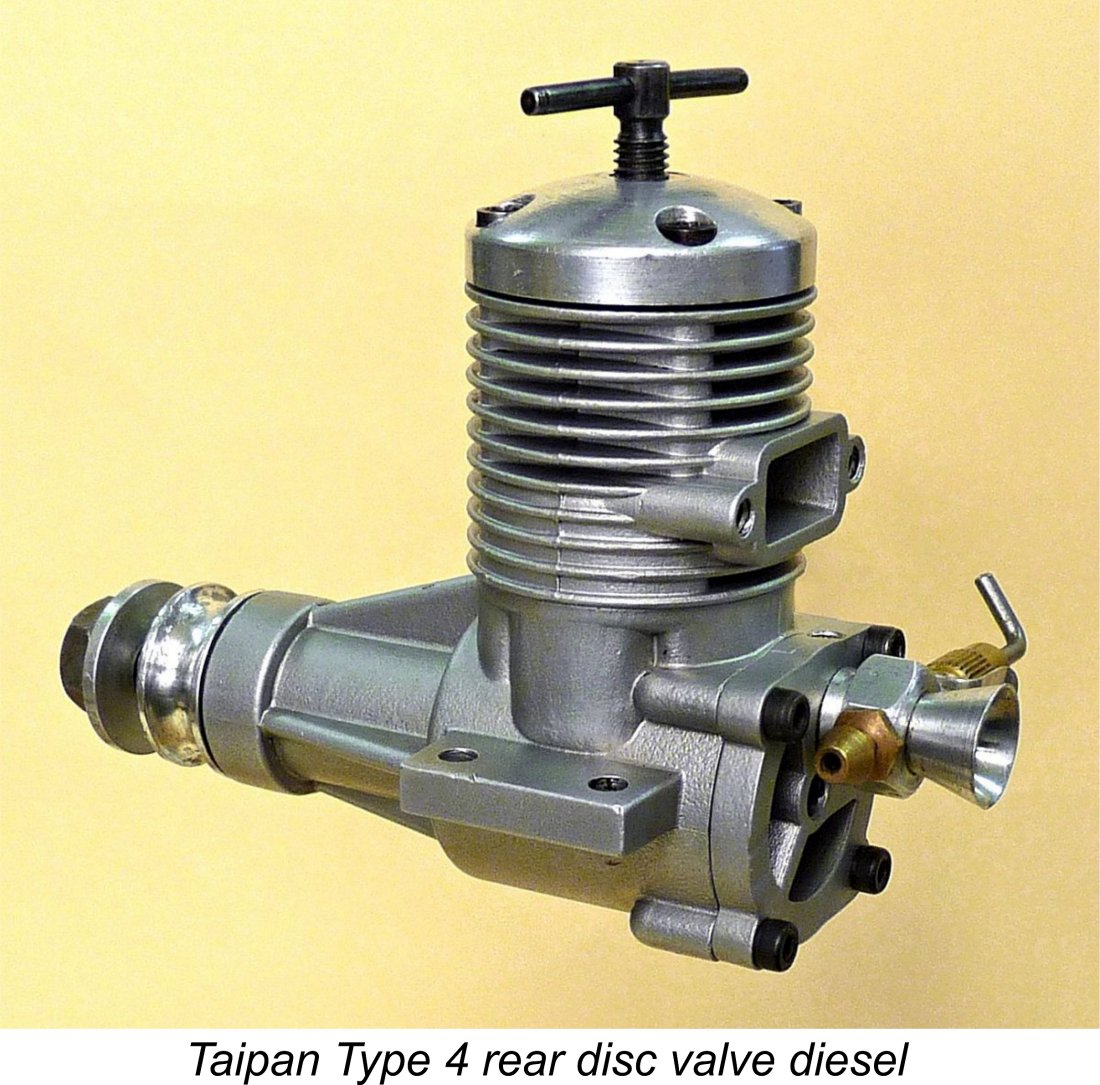
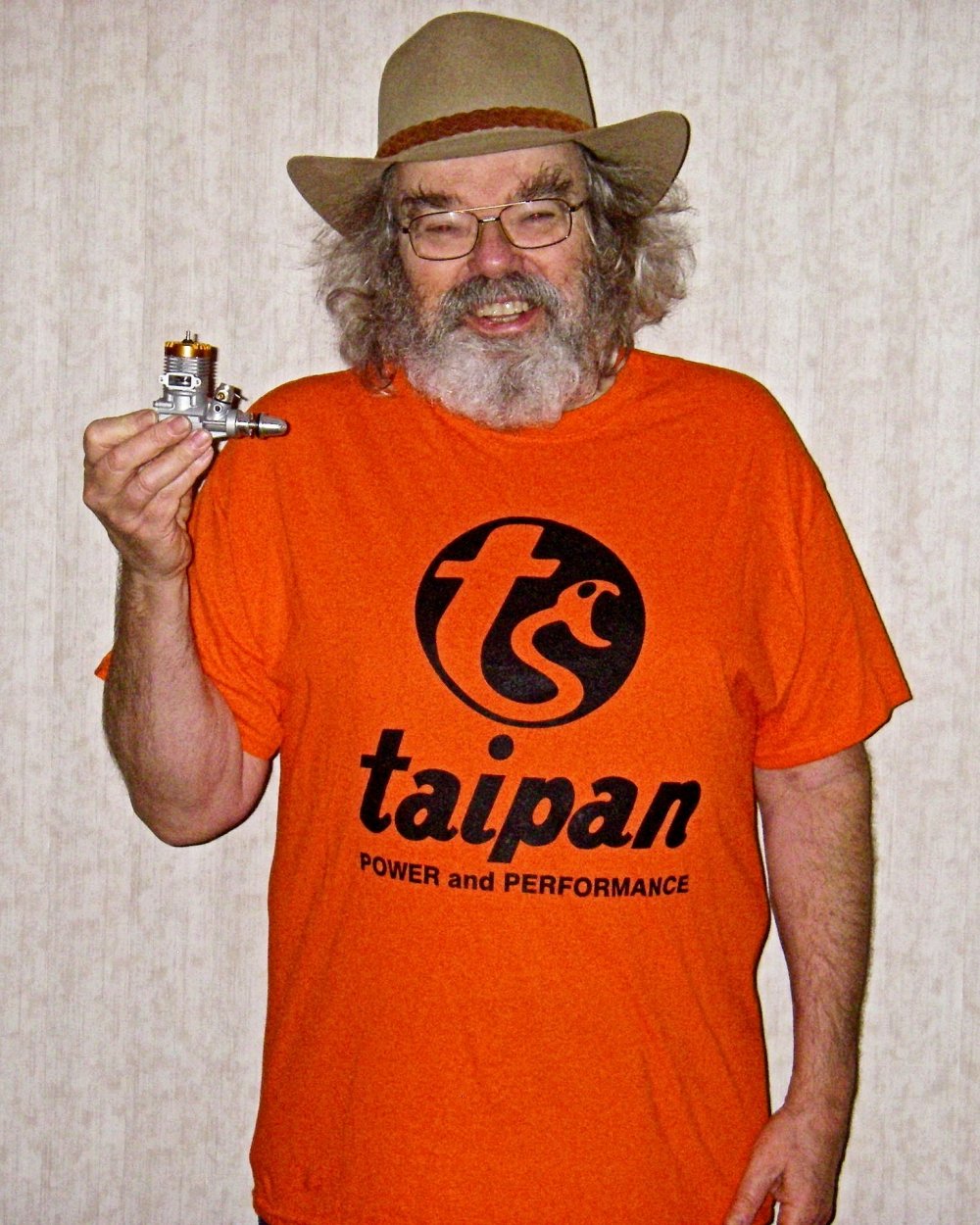 Speaking of David Burke,this seems to be an appropriate opportunity to pay tribute to the efforts of David and his Adelaide Aeromotive Pty. Ltd. company to keep the Taipan flag proudly flying. David has preserved an amazing collection of Taipan materials, including engines, parts, dies and tooling. His superb restorations of a number of rare Taipan and Glo-Chief models have been featured in several articles to be found on this website. He contributed very materially to the creation of Maris Dislers' superb book on the
Speaking of David Burke,this seems to be an appropriate opportunity to pay tribute to the efforts of David and his Adelaide Aeromotive Pty. Ltd. company to keep the Taipan flag proudly flying. David has preserved an amazing collection of Taipan materials, including engines, parts, dies and tooling. His superb restorations of a number of rare Taipan and Glo-Chief models have been featured in several articles to be found on this website. He contributed very materially to the creation of Maris Dislers' superb book on the  For next month, I plan a return to Scandinavia for a close-up look at a relatively little-known racing engine from Denmark - the Mikro 5 cc model of 1951. Although it has often been characterized as a Dooling 29 clone, an in-depth evaluation reveals that the Mikro is in fact a completely original design which, while undeniably incorporating certain elements of the Dooling layout, nontheless embodies a great deal of original thinking. This well-made unit performs at a very acceptable level by 1951 standards, doing great credit to its designer and manufacturer, Kaj Nielsen. It undoubtedly deserved a higher level of success than it actually achieved.
For next month, I plan a return to Scandinavia for a close-up look at a relatively little-known racing engine from Denmark - the Mikro 5 cc model of 1951. Although it has often been characterized as a Dooling 29 clone, an in-depth evaluation reveals that the Mikro is in fact a completely original design which, while undeniably incorporating certain elements of the Dooling layout, nontheless embodies a great deal of original thinking. This well-made unit performs at a very acceptable level by 1951 standards, doing great credit to its designer and manufacturer, Kaj Nielsen. It undoubtedly deserved a higher level of success than it actually achieved.  2.5/1956-D design which had distinguished itself at the 1956 World Control Line Speed Championships. The Vltavan copy was simplified in certain respects, also being constructed to less exacting standards, as a result of which its performance did not match that of the MVVS originals. However, it was a far better performer than its "legend" suggests, hence doubtless doing an excellent job of fulfilling its intended role by providing the average Czech modeller with a readily-available competition engine with which he could gain invaluable experience.
2.5/1956-D design which had distinguished itself at the 1956 World Control Line Speed Championships. The Vltavan copy was simplified in certain respects, also being constructed to less exacting standards, as a result of which its performance did not match that of the MVVS originals. However, it was a far better performer than its "legend" suggests, hence doubtless doing an excellent job of fulfilling its intended role by providing the average Czech modeller with a readily-available competition engine with which he could gain invaluable experience.